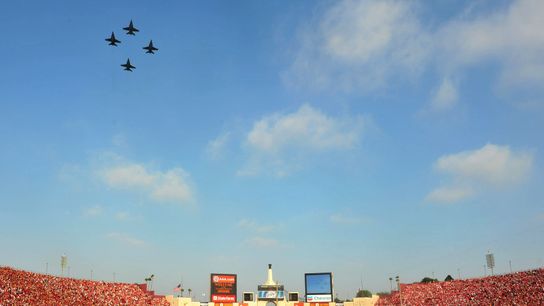LOS ANGELES -- After star quarterback Caleb Williams kept the ball himself and ran it in for the first of his three rushing touchdowns on the evening, he struck the signature "Heisman pose", channeling shades of Desmond Howard three decades prior. The Coliseum crowd erupted. USC was up 17-7, and the stadium was packed. Life was good.
That was the scene last November 26, when Williams and the Trojans took down archrival Notre Dame 38-27 to cap off an 11-1 regular season. The 72,613 fans in attendance at the Coliseum that night was the largest for a USC home game since the stadium's renovation that began following the 2017 season.
The problem is that this wasn't a trend, unfortunately. Despite an extremely successful first season under head coach Lincoln Riley in which the Trojans won 11 games and made the Pac-12 Championship Game and the Cotton Bowl, USC only once drew a home crowd of more than 70,000 fans.
Two weeks earlier, the Trojans hosted Colorado in front of an announced crowd of just 61,206 fans—and that was a rather generous number, too. Yes, the game was played on a Friday night, and yes, Colorado was an abysmal football team in 2022, leading to a 55-17 USC blowout victory. But the fact that a team ranked in the top ten could barely attract 60,000 fans for a home game was largely concerning.
This has been a problem at USC for over a decade now. Outside of marquee matchups against rivals Notre Dame and UCLA (and, once upon a time, Stanford), the Trojans have largely struggled to fill the Coliseum since the conclusion of the Pete Carroll era.
Which is what made Thursday's Big Ten schedule announcement all the more exciting.
In 2024, USC will welcome Michigan and Wisconsin to the Coliseum as part of conference play. In 2025, it will host Penn State and Michigan State, along with UCLA. Combine that with Notre Dame's biennial trip to the Coliseum in 2024 and a high-profile nonconference matchup with Ole Miss in 2025, and suddenly USC's home schedule looks more exciting than it has in a long time.
While Alabama and Georgia fans will pack their respective home stadiums for matchups against Ball State and UT Chattanooga, the unfortunately reality is that USC fans are not like that. (Personally, I have attended every USC home game in which fans were allowed since I started at the school in August of 2019, but I am definitely in the minority.) The fact of the matter is, in order to get the fans to show up in Los Angeles, you need to provide them with high-profile matchups. And with all due respect to the likes of Oregon State and Cal, games against those programs aren't exactly enticing enough to convince USC fans to pack the Coliseum in full force.
But with the Trojans' impending move to the Big Ten, things may start to shift. All of a sudden, USC will be welcoming programs such as Penn State and Michigan to the Coliseum on a regular basis. And when that happens, fans may begin to pack the Coliseum once again—just as they did in a bygone era when Los Angeles had no NFL teams and Pete Caroll, Matt Leinart, and Reggie Bush were the football kings of the city.
Of course, in order for that to happen, Lincoln Riley and his staff will need to continue to build a winning program on the field. No one will want to watch Ohio State come into the Coliseum and hang 62 points on the Trojans—just as Oregon infamously did in front of over 93,000 fans back in 2012.
But if Riley can continue to build off of last year's 11-win campaign and put together an annual playoff contender in Los Angeles, then perhaps the new schedule will prompt fans to finally show out in full force.
When former USC Athletic Director Mike Bohn introduced Riley as USC's head football coach in November of 2021, he boldly proclaimed, "this sleeping giant is wide awake." Well, perhaps the new schedule will be enough to wake the fans up, too.
